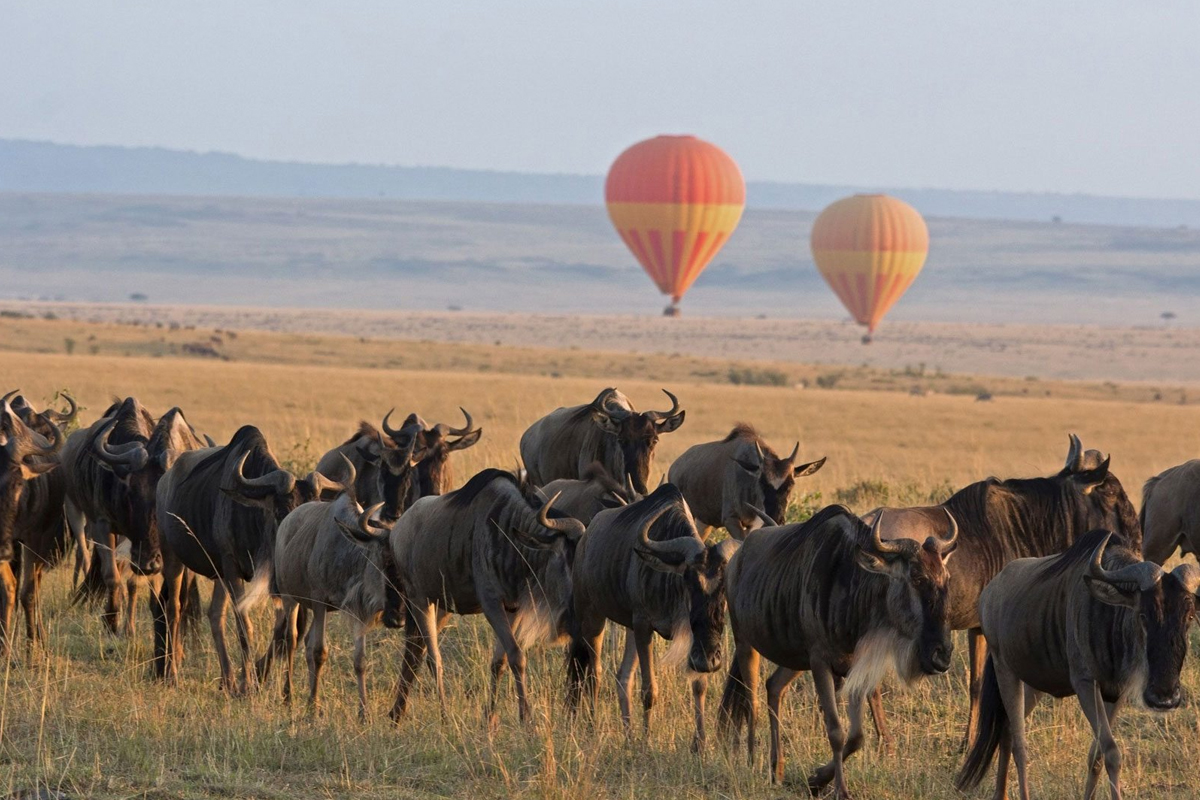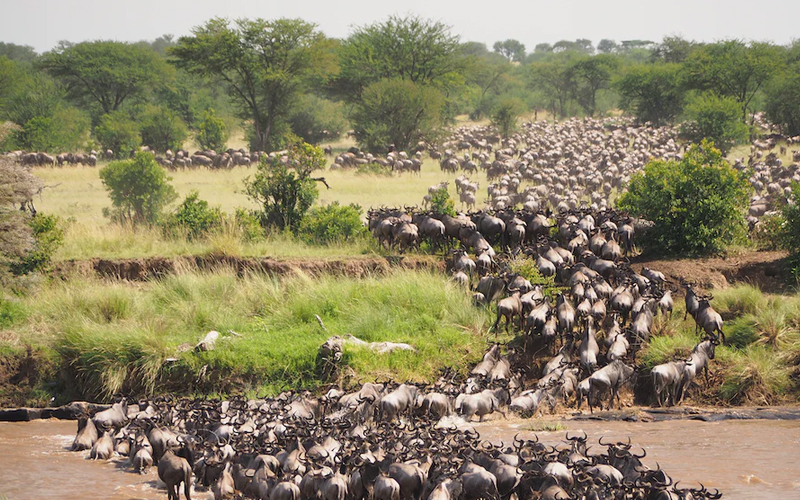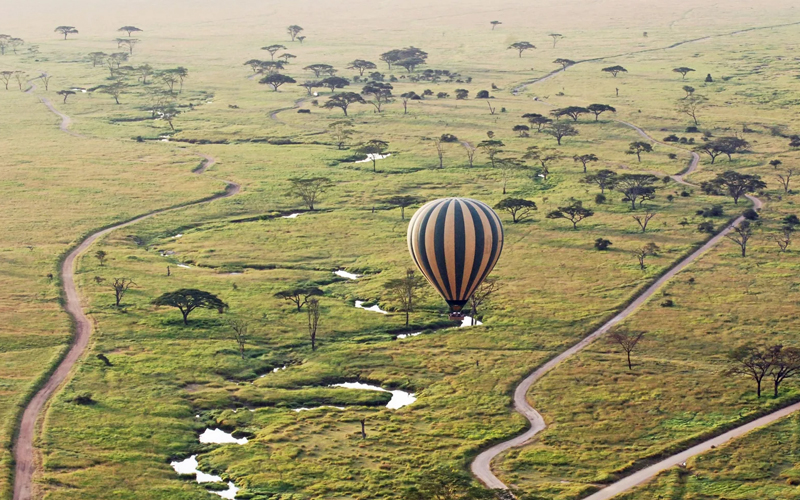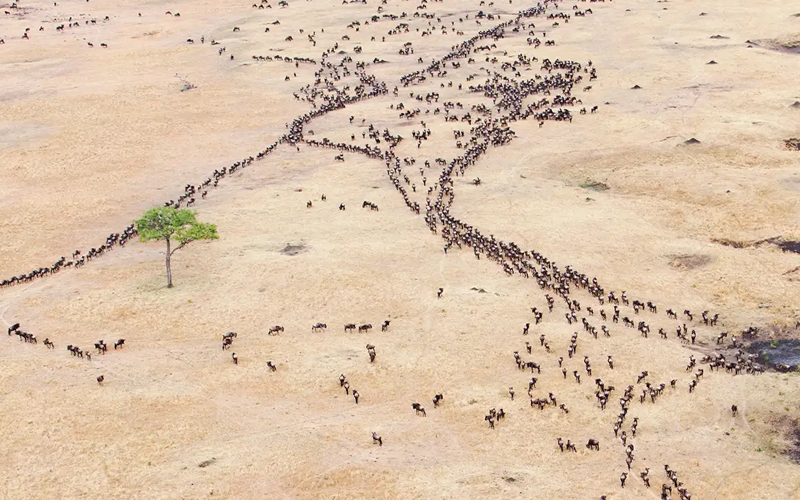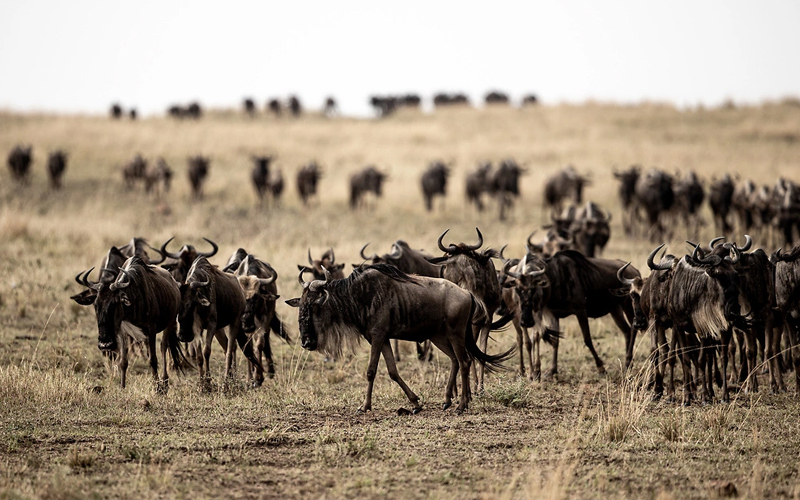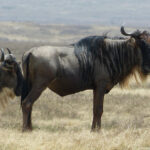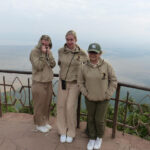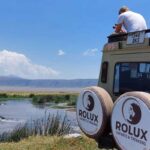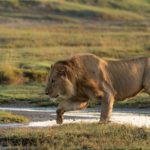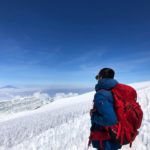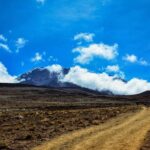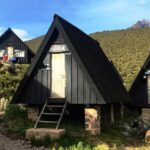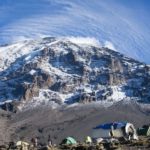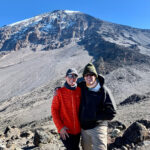The Great Wildebeest Migration, a mesmerizing spectacle that unfolds annually across the Serengeti and Maasai Mara, is one of nature’s most breathtaking events. While witnessing this phenomenon from the ground is awe-inspiring, experiencing it from above offers a unique and unparalleled perspective. An aerial safari provides a bird’s-eye view of the vast herds, dramatic river crossings, and the intricate dance of predators and prey, making it a must-do for wildlife enthusiasts and adventure seekers alike.
Soar Above the Wildebeest Migration
The Spectacle of the Wildebeest Migration
Annual Cycle and Route
The Great Migration is a year-long journey involving over 1.5 million wildebeest, accompanied by hundreds of thousands of zebras and gazelles. Their route forms a large loop from the southern Serengeti in Tanzania to the Maasai Mara in Kenya and back again, driven by the search for fresh grazing and water.
Key Locations: Serengeti and Maasai Mara
The migration traverses two of Africa’s most iconic wildlife reserves: the Serengeti National Park and the Maasai Mara National Reserve. These regions provide diverse landscapes and habitats, from open plains to riverine woodlands, each playing a crucial role in the migration.
Why Choose an Aerial Safari?
Unparalleled Views
An aerial safari offers a vantage point that is simply unmatched. From above, you can fully appreciate the sheer scale and organization of the wildebeest herds as they move in unison across the landscape. The sweeping vistas of the Serengeti and Maasai Mara are spectacular when viewed from the sky.
Avoiding the Crowds
Ground-based safari vehicles can sometimes cluster around key migration points, such as river crossings, leading to crowded and less intimate experiences. In contrast, an aerial safari allows you to observe the migration without the hustle and bustle, providing a serene and unobstructed view.
Enhanced Photography Opportunities
Photographers will find aerial safaris particularly rewarding. The aerial perspective allows for unique photographic compositions, capturing the vastness of the migration and the dramatic scenery below. The soft morning light during early flights can add a magical quality to your photos.
Types of Aerial Safaris
Hot Air Balloon Safaris
Hot air balloon safaris are a popular choice for viewing the migration. These early morning flights offer a peaceful and silent glide over the plains, providing a gentle and immersive experience. The slow pace allows for extended observation of the wildlife below.
Helicopter Tours
Helicopter tours offer greater maneuverability and the ability to hover over specific areas. This flexibility is ideal for tracking the movement of the herds or observing predator-prey interactions. Helicopters can also access more remote and less frequented parts of the migration route.
Light Aircraft Flights
Light aircraft flights provide a faster-paced option for covering larger areas of the migration. These flights offer an expansive view of the landscape and are particularly useful for getting a broad overview of the migration’s progress.
Best Time for an Aerial Safari
Seasonal Highlights
- January to March: Calving season in the southern Serengeti, where thousands of wildebeest calves are born.
- April to June: The herds move northwards, creating dynamic scenes of movement.
- July to October: River crossings at the Grumeti and Mara Rivers, offering dramatic and intense viewing opportunities.
- November to December: The herds return south to the Serengeti, covering vast distances.
Optimal Weather Conditions
Early morning flights are typically preferred due to calmer winds and more stable atmospheric conditions. The light during these hours also enhances visibility and photography. Weather conditions are generally more favorable during the dry seasons.
Planning Your Aerial Safari
Choosing the Right Operator
Selecting a reputable and experienced safari operator is crucial. Look for operators with well-maintained aircraft, knowledgeable pilots, and good safety records. Operators who prioritize sustainable and ethical tourism practices are also preferable.
What to Expect During the Flight
Flights usually start early in the morning, with the entire experience lasting a few hours. After a pre-flight briefing, you’ll embark on your journey, soaring above the plains and following the movements of the herds. Pilots often provide commentary on the wildlife and landscapes below.
Safety Considerations
Safety is paramount on an aerial safari. Ensure that your operator follows all safety regulations and that you receive a thorough briefing before takeoff. It’s also important to follow all instructions from the pilot and crew during the flight.
Experiencing the Migration from Above
Witnessing River Crossings
One of the most thrilling aspects of the migration is the river crossings. From above, you can see the entire scene unfold, from the wildebeest massing on the banks to the dramatic plunge into the water and the ensuing chaos as they navigate the crocodile-infested rivers.
Seeing Herd Movements and Patterns
An aerial view allows you to appreciate the complex and coordinated movements of the herds. You can observe how they spread out to graze, form protective circles around young calves, and respond to predator threats.
Spotting Predators and Other Wildlife
From the sky, it’s easier to spot predators stalking the herds or resting in the shade. You may also see other wildlife such as elephants, giraffes, and rhinos, as well as diverse bird species that inhabit the area.
Complementing Your Aerial Safari
Ground-Based Game Drives
While an aerial safari offers a unique perspective, ground-based game drives are essential for getting closer to the action. These drives allow you to observe animal behavior in detail and enjoy the sounds and smells of the bush.
Walking Safaris
For a more intimate and immersive experience, consider a walking safari. Guided by experienced rangers, you can explore the terrain on foot, learning about the flora and fauna up close.
Cultural Excursions
Enhance your safari experience by visiting local Maasai villages. Learn about their culture, traditions, and way of life, and support the community by purchasing handmade crafts and participating in traditional activities.
Photographic Opportunities
Capturing the Scale of the Migration
The vast herds of wildebeest create stunning visual patterns across the landscape. From above, you can capture the full scale of their movement, creating dramatic and impactful images.
Tips for Aerial Photography
- Use a Fast Shutter Speed: To counteract the movement of the aircraft, use a fast shutter speed to keep your images sharp.
- Polarizing Filter: A polarizing filter can reduce glare and enhance the colors of the landscape.
- Wide-Angle Lens: While a zoom lens is useful, a wide-angle lens can capture expansive views.
Recommended Equipment
Bring a high-quality DSLR or mirrorless camera with a zoom lens (200-400mm) and a wide-angle lens (16-35mm). Extra batteries and memory cards are essential, as well as a padded camera bag for protection.
Conservation and Sustainability
Impact of Aerial Safaris on Wildlife
Aerial safaris have a lower impact on wildlife compared to ground vehicles, as they minimize habitat disturbance and avoid close encounters that can stress the animals. This makes them a more sustainable option for wildlife viewing.
Supporting Conservation Efforts
Many aerial safari operators support conservation projects through donations and by raising awareness. By choosing responsible operators, you can contribute to the preservation of the Serengeti and Maasai Mara ecosystems.
Eco-Friendly Practices
Ensure that your safari minimizes its environmental footprint by following eco-friendly practices. This includes using renewable energy sources, reducing waste, and supporting local conservation initiatives.
Soaring above the Great Wildebeest Migration is an experience like no other. The aerial perspective reveals the full majesty of this natural wonder, offering unforgettable views and unique photographic opportunities. By carefully planning your aerial safari and supporting ethical and sustainable tourism practices, you can enjoy this extraordinary adventure while contributing to the conservation of Africa’s incredible wildlife.
FAQs
How safe are aerial safaris over the wildebeest migration?
Aerial safaris are generally very safe, provided you choose a reputable operator with experienced pilots and well-maintained aircraft. Always follow safety briefings and instructions from the crew.
What should I wear for an aerial safari?
Dress in comfortable, layered clothing suitable for the early morning chill, and wear a hat and sunglasses to protect against the sun. Neutral colors are recommended to avoid startling wildlife.
How long do aerial safaris usually last?
Aerial safaris typically last between 1 to 3 hours, depending on the type of flight and the specific itinerary. Hot air balloon flights usually include a post-flight breakfast and champagne toast.
Can I combine an aerial safari with other types of safaris?
Yes, many safari packages offer a combination of aerial safaris with ground-based game drives, walking safaris, and cultural excursions to provide a comprehensive wildlife experience.
Are aerial safaris suitable for children?
Aerial safaris can be suitable for children, but it depends on the child’s age and temperament. Consult with your operator to determine if the experience is appropriate and to discuss any specific requirements or considerations.
Embark on an unforgettable journey through Tanzania’s breathtaking landscapes and wildlife wonders. Immerse yourself in the iconic Serengeti, where the awe-inspiring wildlife migration unfolds before your eyes. Marvel at the abundant biodiversity of the breathtaking Ngorongoro Crater. Don’t miss the exhilarating hike up Kilimanjaro, Africa’s highest peak, for an unparalleled adventure. Then, unwind with a serene beach retreat in Zanzibar. Join us for the ultimate Tanzania Safari tour!

